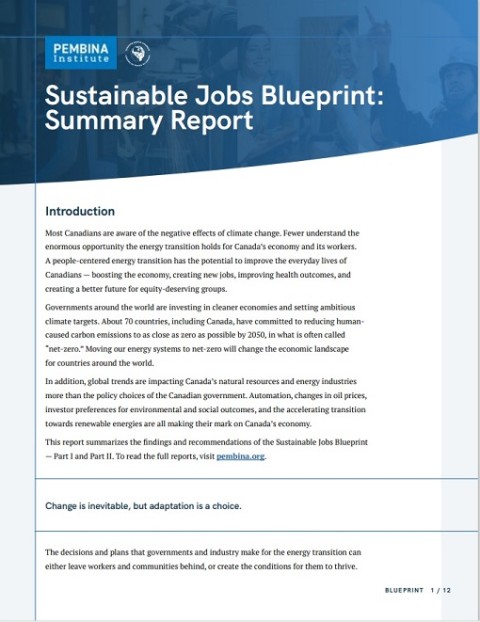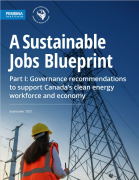In the fall of 2022, the Canadian Labour Congress and the Pembina Institute came together, representing labour and environmental perspectives, to ask the question: how do we prepare for a changing economy in a way that meets environmental commitments and creates decent jobs? To answer that question we held conversations with workers and experts, examined successes from other countries, and undertook economic modelling to understand how the energy transition could impact workers and the economy by 2050.
We wrote two reports on the topic. The first report advised the Government of Canada on what it needs to do to ensure its “sustainable jobs” planning will support workers and communities. The second report outlined the policies and investments necessary to equip workers with the right skills, improve the social security net, and support regional and national economic prosperity for the best employment and economic outcomes.
Enormous opportunities lie ahead. By 2050, growth in clean energy industries will create more jobs than will be lost, even in provinces with many jobs in fossil fuel production and use. By putting the right policies and plans in place, governments can ensure that these clean industries succeed, and that workers have the right skills to take advantage of new job opportunities.
This report summarizes the findings and recommendations of the Sustainable Jobs Blueprint, Part I and Part II.
Data based on an economic analysis of Canada reaching net-zero by 2050.
What is a net-zero economy?
A net-zero economy continues to deliver goods and services, and a high quality of life, while powered by emissions-free energy. Aligned with Canada’s climate change commitments, this means climate policy and economic policy come together so that we follow those pathways most likely to help us achieve net-zero emissions by 2050 in a manner that prioritizes emissions reductions over removals or offsets.
What is a sustainable job?
The Government of Canada defines a “sustainable job” as a job that aligns with Canada’s emissions reduction targets and provides good working conditions and decent work standards. It is “sustainable” from an environmental perspective, and high-quality from a labour perspective.
What makes good sustainable jobs policy?
Acting on climate change and spurring decent job creation are two sides of the same coin. Both these objectives require the federal government, working with other levels of government, to establish a robust plan to achieve an orderly transition and fair outcomes for workers.
The following elements must be part of this plan. They are the scaffolding that provide the structure for sustainable jobs initiatives to be successful.
- Adequate resourcing: Significant financial resources are needed to make the shift to a clean energy economy a reality. Investments and programs that grow sustainable jobs must have sufficient resources to have a positive impact for workers, communities, and underrepresented groups.
- Alignment with net-zero: Plans to transition Canada’s workforce to sustainable jobs must ensure that jobs are aligned with Canada’s carbon reduction plans, and avoid the risk of workers becoming stuck in declining industries.
- Cohesive strategy and vision: A sustainable jobs plan must be a part of the Government of Canada’s broader climate agenda so that workers and communities understand what the future looks like and can plan accordingly.
- Regional collaboration: Transitions unfold at the regional and local level. A nation-wide sustainable jobs plan should reflect this reality, with all levels of government involved. Implementation tactics must be grounded in local values and address the challenges and opportunities unique to each place.
- Social dialogue: Workers and labour need a seat at the decision-making table. Workers, communities, and underrepresented groups should be a part of sustainable jobs governance structures and implementation.
- Worker buy-in: Workers need to feel confident that sustainable jobs initiatives meet their needs. Policies and plans must be clearly communicated to workers, through trusted channels.
Canada's climate strategy is also an economic strategy. Changes in energy systems, the labour market, and the economy are here to stay, so sustainable jobs planning and climate policy must go hand in hand.
This Sustainable Jobs Blueprint argues for government to follow through on its promises and make bold investments to help workers prepare for a changing economy and climate. Such investment in workers and communities can also reduce labour shortages, make life more affordable by reducing reliance on price-volatile fossil fuels, and provide more decent jobs.
In addition, industry, government bodies at all levels, community leaders and unions all have a vital role to play. Workers themselves can be key partners to take these ideas and develop them further. With workers onside, the transition can move at the speed that the climate emergency demands.
Canada can and should capitalize on the benefits of the clean energy transition and move towards a fairer society where workers are themselves the engineers of the future they deserve.





